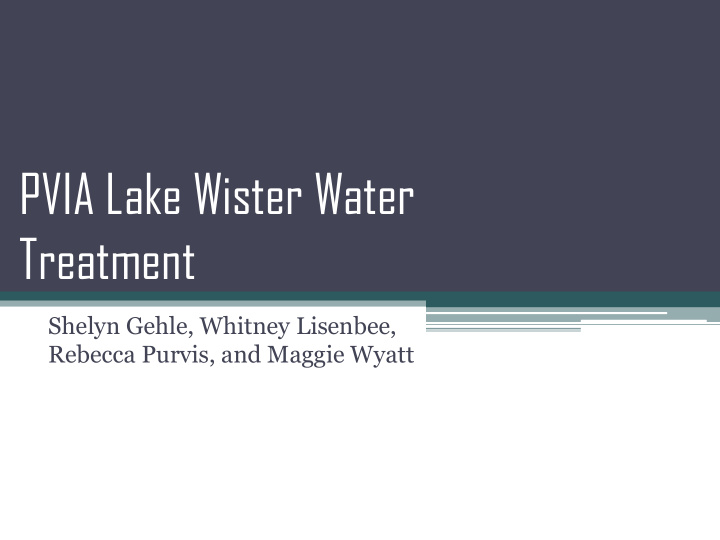



PVIA Lake Wister Water Treatment Shelyn Gehle, Whitney Lisenbee, Rebecca Purvis, and Maggie Wyatt
Background on PVIA • Poteau Valley Improvement Authority (PVIA) Water Treatment Plant • Treats and distributes water to about 80% of LeFlore County, OK • Water source: Lake Wister • Pulls on average 6 million gallons of water/day
Water Balance • Quarry Island Cove Volume = 1418 ac-ft Accumulation = Inputs – Outputs ▫ assume steady-state • Inputs: ▫ Precipitation = assume 0 ▫ Water entering cove from lake • Outputs: 588 ac-ft/month ▫ Evapotranspiration = 4ft/yr ▫ Pumped out = 6MGD
Current Problems • High phosphorous and algae levels in the lake • P is the limiting nutrient for algal growth • P concentration is indicated by levels of Chlorophyll-A in lake ▫ Must not exceed DEQ standards of 0.01 mg/L for Chlorophyll-A
Phosphorous and Chlorophyll-a Levels
Current Problems • PVIA Treatment Plant has to remove P by adding Alum • Creates large volumes of “water treatment residual” (sludge) during treatment process ▫ Pumped to nearby pasture and spread out ▫ 1/12 of labor costs ▫ Current procedure subject to change
Alum Treatment • Aluminum Sulfate [Al 2 (SO 4 ) 3 ] ▫ Reacts with phosphorus and creates a precipitant ▫ Precipitant settles • Currently only used in treatment plant ▫ Treatment uses 5,000 gallons of Alum/week ▫ Alum cost: $1/gallon
Project Objectives • Create an Alum Microfloc Curtain • Allow for continual decrease in P concentration ▫ Reduce algae and cyanobacteria levels ▫ Reduce Disinfection By-Products (DBP) and toxins in treated outflow ▫ Keeping below state regulations • Develop a treatment usage schedule
Constraints • ¼ mile cove opening • Materials must withstand highly corrosive lake • Compressor must be above floodplain • Compressor depends on number of running units • Power availability limited by road access • Treatment varies by season • Cannot interfere with cove recreational activities
Diffuser Discs Pros • Common • Weighted • Good mixing • Familiarity Cons • Cannot be in series • Pressure regulators • Moderately expensive https://www.outdoorwatersolutions.com/store/dual-disc-rubber-membrane- diffuser-with-base-and-risers-p-248.html
Problems with Diffuser Discs
Bubble Tubing Pros • Weighted • Continuous curtain • Easy installation • Easy maintenance Cons • High Pressure • Small OD • Needs supports http://www.canadianponds.ca/Bubble-Tubing-linear-industrial- diffuser.aspx
Potential Materials OctoAir-10 Industrial Diffuser Porous PVC http://www.canadianponds.ca/en/octoair-10-diffuseur-industriel-octoair- http://www.alita.com/diffuser/polyethylene.php 2?cc=bubbletub
Liquid Alum Release • Connected to continuous Kenco Chemical Injectors Alum pipe • Placed above diffusers ▫ Oriented in any direction ▫ Check valves ▫ Minimize chemical http://kenco-eng.com/product-info/chemical-injectors build-up ▫ Function under wide pressure range ▫ High flow rate
Solid Alum Release • ChemLog ▫ 40 lb blocks ▫ Held above diffusers Pros: ▫ Easy release ▫ Less equipment Cons: ▫ Must replace often ▫ Not consistent ▫ More expensive
Layout 1
Layout 2
Layout 3
Patents • Patent No. 7,074,328 ▫ Connects diffusers in branches using regulators ▫ Does not have Alum components • Potentially patent process and final design
Next Steps • Find large test facility • Purchase or construct various diffuser systems • Test Alum dispersion and effectiveness • Determine effects on lake chemistry
Testing Procedures - Diffusers • Test facility: ▫ At least 15 ft deep • Use small compressor/blower • Implement pilot test system • Observe: ▫ bubble movement ▫ velocity ▫ mixing
Testing Procedures - Alum • May need a different facility • Currently determining best way to observe dispersion • Mix with raw water samples ▫ Determine sludge production ▫ Calculate settling velocity
Alum Chemistry • Low alkalinity and pH creates a corrosive lake ▫ Alkalinity: avg. 19 mg/L as CaCO 3 (range 8-42) ▫ pH: 6.5 to 9.5 • Alum reacts with current lake chemistry ▫ Reduces alkalinity of lake ▫ May need to add lime • Each reaction affects other reactions ▫ Carbonate system analysis
Final Tasks • Determine compressor/blower requirements • Treatment usage schedule • Complete cost-benefit analysis on each design • Regulatory permits
Acknowledgements • Steve Patterson Environmental Consultant • Don Goforth Manager • David Wyatt Consulting Engineer – PVIA • Ken Hammond Chairman – PVIA • Keith Wright Board Member – PVIA • Mick LaFevers Secretary Treasurer – PVIA
Acknowledgements • Dr. Dan Thomas • Dr. Garey Fox • Dr. Dan Storm • Freshmen: ▫ Grant Moore, Danielle Dockrey, Justin Morgan, and Tucker Whitlow ▫ Hannah Barber, Amethyst Kelly, Talia Branham, and Jordan Rogers
Questions?
Recommend
More recommend